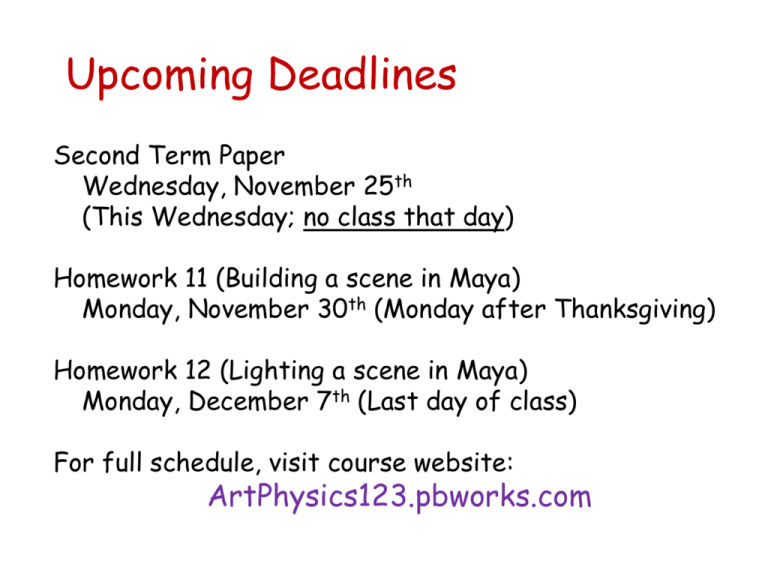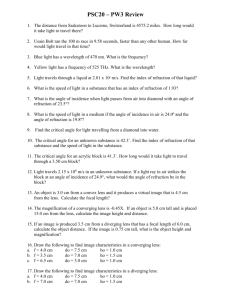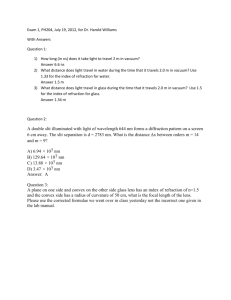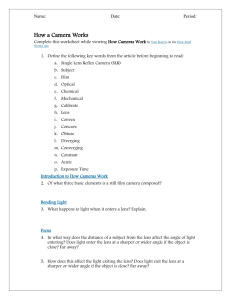Uniform Motion
advertisement

Upcoming Deadlines Second Term Paper Wednesday, November 25th (This Wednesday; no class that day) Homework 11 (Building a scene in Maya) Monday, November 30th (Monday after Thanksgiving) Homework 12 (Lighting a scene in Maya) Monday, December 7th (Last day of class) For full schedule, visit course website: ArtPhysics123.pbworks.com Homework Assignment Using Autodesk Maya create a scene consisting of a floor, a single wall in the background, and some objects in the foreground in the form of the initials of your name. Render the scene, save the image, and upload it to your blog. Due by 8am on Monday, November 30th. 20 points (if late, 10) Created by Candace Downey Final Exam Final Exam will have of 10 short essay questions on material covered in lecture. Final exam counts for 50 points. Sample Questions: * What is the difference between stride and gait? How do they affect the walking speed? * Describe how a scene would be lit using three point lighting. Final Exam Final exam is scheduled for: Wednesday, December 16th In this room from 1215—1430 You may take the final early on: Wednesday, December 9th In this room from 1500—1700 Special Campus Event Animation Show of Shows December 7th (Monday) At 7:30 PM Morris Dailey Auditorium in Tower Hall FREE Optics & Lighting Part II: Bending & Scattering Global Illumination Advanced computer graphics uses global illumination algorithms to compute a more physically realistic rendering of a scene. Without GI With GI Notice focusing of light through glass sphere Caustics Caustics are the bright concentrations of light caused by the focusing of that light when passing through a transparent object. Caustics also create shadow patterns, such as the bright and dark pattern in a swimming pool, due to the deflection of the light. Refraction Light rays bend (refract) passing from water to air, making objects appear to be shallower and closer to the observer. Observer sees image Image Image Actual Actual Law of Refraction Light passing from one material to another is refracted by an angle that depends on the optical density of each material. Angle is smaller in the denser material. Demo: Refraction thru a Block Light is refracted entering the block and refracted back on leaving the block. Optical Density Optical density is given by the index of refraction, n. Air The larger the difference between the indices at an interface, the larger the angle of refraction for light rays crossing the interface. Air Water Glass Air Diamond n = 1.0 n = 1.3 n = 1.0 n = 1.5 n = 1.0 n = 2.4 Demo: Invisibility Mineral oil and glass have nearly the same index of refraction A glass rod is nearly invisible in a beaker of mineral oil. A diamond, however, is easily seen. Refraction in a Wedge Which path does light ray take after entering the glass wedge? A)Path A B) Path B C) Path C A B C WEDGE Refraction in a Wedge Path B The angle always bends towards the perpendicular going from air to glass. Notice that it bends away from the perpendicular going back out of the glass. A B C WEDGE Mirages Mirages are caused by the refraction of air because hot air has lower optical density than cold air. Cool Air Hot Air Total Internal Reflection When refraction angle exceeds 90º the light does not cross the surface. Demo: Total Internal Reflection Past the critical angle all the light is internally reflected. Just below critical angle Demo: Total Internal Reflection Prism demonstrates total internal reflection if the angle of incidence is large enough. No light escapes to this side No light escapes to this side No light escapes to this side Looking up Underwater Try this when you’re in the pool or the ocean next summer. Looking straight up you see the sky but outside the 96° cone surface is like a mirror Natural Lighting Underwater Due to total internal refraction sunlight never enters the water at more than about a 45 degree angle. Image seen underwater Sun Fiber Optics Total internal reflection causes light to reflect inside a solid glass tube. Lenses Curvature of a lens surface produces a continuous, variable angular refraction. Concave lens shrinks its image Convex lens magnifies its image Demo: Concave Lenses Curved surface of a concave lens causes light rays to diverge, dispersing the light and shrinking any images. Demo: Convex Lenses Curved surface of a convex lens causes light rays to converge, focusing the light and possibly magnifying images. Demo: Real Image of Convex Lens Image formed by convex lens can be observed on a screen. Pinhole Camera Small pinhole allows only small amount of light in, blocking overlapping diffuse rays and forming image inside the camera. Demo: Pinhole Lens Make a small pinhole in a piece of cardboard. You’ll find that you can focus better when looking through the pinhole. E TG WRP This works best if you remove any corrective lenses, such as contacts and eyeglasses. OCVM XSRYU QBNEHD Camera Obscura The camera obscura (room darkened) dates to ancient times; it was first detailed in the writings of Leonardo da Vinci. A room is completely sealed from light except for a coinsized hole in one wall. An image of the outside world appears projected, upside down and reversed right-toleft, onto a wall opposite the opening. Diffuse light Giant Camera Camera obscura with a projecting mirror. Mirror Next to the Cliff House, San Francisco Mirror Johannes Vermeer (1632-75) Common elements in his paintings and ray tracing analysis suggest that this great Dutch artist may have built a camera obscura in his studio. The Music Lesson Vermeer Camera Lens Using a lens allows for more light to be focused on the camera screen or film. No image (Diffuse) Camera obscura Camera with lens The Lens of the Eye The eye’s lens changes shape to focus the image onto light sensitive cells of retina. Image is formed upside-down on the retina of the eye. Visual Acuity If eye’s lens is unable to form image on the retina, an object will appear out of focus. Myopia Hyperopic Eyeglasses Lenses of eyeglasses restore visual acuity by combining with the eye’s lens to form focused image onto retina. Eyeglasses began to appear in common use in the 13th century. They may have been invented in northern Italy but Marco Polo reports them in China as early as 1275. Detail of portrait of Hugh de Provence, Tomasso da Modena, 1352 Pinhole glasses Astigmatism Astigmatism due to eye’s lens being elliptical, which causes the focus in the vertical to differ from horizontal. Vertical focus Astigmatism may be corrected using a cylindrical lens. In this example, the lens focuses in the horizontal only since vertical is already in focus. Spectrum of Visible Light Demo: Infrared Light Digital cameras, such as in cell phones, are sensitive to infrared light, such as from a remote control or any hot object. Microwave Transmitter Microwave Receiver Separating Colors Blue wavelength of light refracts slightly more than the red, creating rainbows. Water Droplet Glass Prism Rainbows Rainbows are formed by refraction from many, many raindrops. The red part is always above the blue part. Double Rainbow Primary Secondary Diamond Cuts Diamonds are cut so as to create a beautiful jewelry by taking advantage of total internal reflection and high color dispersion (prism effect). Atmospheric Perspective Objects in the distance have a bluish, unsaturated color due to atmospheric scattering of blue light (same as blue sky). Atmospheric Perspective Example “Perspective of Color” Not only did he make good use of what he called “Perspective of Color” but Leonardo also correctly predicted that this is why the sky is blue. The Virgin of the Rocks, Leonardo, 1482 Light Scattering Mie Scattering Direct scattering by suspended particles, such as dust, fog, etc. Rayleigh Scattering* Refraction by random variations in a transparent medium. For both types of scattering blue light tends to scatter more strongly than red light. Also called Rayleigh-Brillouin Scattering* Mie Scattering Examples Volumetric Lighting Volumetric lighting is used to create the volume of scattered light, usually due to Mie scattering. Next Lecture Seeing Color No class this Wednesday but Second Term Paper due on Wednesday Please return the clickers!








